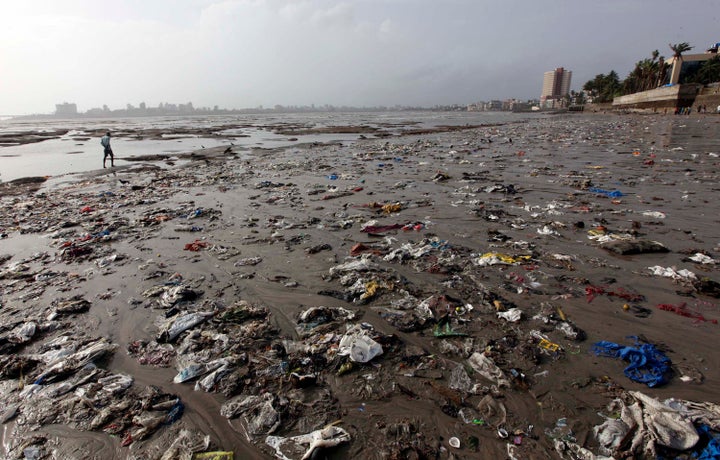
Before you head to the beach this Fourth of July weekend, no doubt you will check the forecast for any impending bad weather. But to avoid some potentially worse spoilers -- such as a bout of diarrhea or a nasty skin rash -- you might also want to consider consulting another report.
According to the National Resource Defense Council's (NRDC) "Testing of the Waters: A Guide to Water Quality at Vacation Beaches" annual survey, there were 24,091 beach closings and advisories in the U.S. in 2010. That is the second-highest number in more than 20 years.
The report, released Wednesday by the nonprofit environmental organization, notes that 8 percent of monitoring samples from more than 3,000 beaches in 30 coastal and Great Lakes states exceeded public health standards in 2010. In two-thirds of the cases, bacterial contamination was to blame.
"That's a lot of dirty water," Jon Devine, senior attorney at the NRDC, said during a press conference Wednesday.
But there's some good news. Experts suggest that improved methods of prevention, monitoring and communication could significantly limit the number of beachgoers -- often vulnerable children, seniors and individuals with compromised immune systems -- sickened after ingesting or absorbing contaminants through their skin.
The report points a finger at 10 beaches in California, Florida, Illinois, New Jersey, Ohio, Texas and Wisconsin (see below list) that have repeatedly fallen below the public health standard, which assumes that pollution in marine beaches will sicken 19 out of every 1,000 people exposed to the water.
"If the water is worse than that standard," Devine explained, "then you're even more likely to get sick."
This year, for the first time, the NRDC also gave kudos to four "superstar" beaches in Delaware, Minnesota and New Hampshire, which consistently test for and report clean water (also below).
Beach water quality depends on a range of factors. In 2010, both the Gulf oil spill and heavy rainfall in Hawaii and California were factors that contributed to the poor marks. A deluge of rain, for example, can cause runoff from urban and suburban stormwater, carrying human and animal waste, fertilizers and other pollutants to the beach.
"In those areas where [climate change] will cause increased precipitation, we can expect increased stormwater pollution," Devine noted in an email to The Huffington Post. "And where increased pollution also overlaps with places with combined sewer systems like the Great Lakes, those kinds of events could also increase."
Many of the beaches that scored well in this year's report have taken action to reduce runoff, manage combined sewer systems or treat any water that drains into the beach water, explained David Beckman, NRDC water program director.
"Communities that want clean beaches need to prioritize stormwater management," added Elizabeth Halliday, a Ph.D. candidate at the Massachusetts Institute of Technology/Woods Hole Oceanographic Institution's Joint Program in Biological Oceanography and lead author of a recent study that evaluated the oft-overlooked impact of polluted beach sand.
"Stormwater can have a longer lasting impact by introducing fecal bacteria to beach sands, from which they can later be re-suspended into the water, again negatively impacting beach water quality and potentially bather health," she told The Huffington Post in an email.
Devine noted that at least one community in Racine, Wis., has adjusted its beach grooming techniques to try to maximize the die-off of bacteria in the sand.
Still, even the cleanest beaches can have bad days, said Beckman. Frequent monitoring and fast detection is key.
"Only when we have good and rapid testing results will we really be able to protect people at the beach," he added. "If a test is taken at a beach on Saturday morning, it typically takes 24 to 48 hours to get results. That means you can have a whole summer weekend of people using a beach and then find out Monday morning that the beach had unsafe levels of bacteria. It's too late."
The NRDC is urging the EPA to adopt faster testing methods that can provide more timely information.
Of course, regardless of how fast or thorough a test is, it won't be useful unless its results are passed along to the public. Another recent study found inconsistencies in monitoring frequencies, criteria for preemptive warnings and closures after a weather event, as well as the color coding used for the notifications.
"We know a lot about how to test the water. We don’t know much about how to communicate the results to the public, and as a result, it’s done differently in different states," said Preethi Pratap, lead researcher at the University of Illinois Chicago School of Public Health. "If systems for communication at beaches are improved -- such as expanded use of text messages and social networking sites -- it may help alert the public to other hazards."
In addition to checking online or calling your government office that manages beach water quality to get the latest advisories, you can protect yourself by avoiding the beach within 72 hours of rain.
"Last but not least, use common sense," said Devine. "If the water looks or smells funny, don't go in."
"Repeat Offenders" (Beaches with more than 25 percent of samples exceeding the EPA's standards each year, 2006-2010)
- California: Avalon Beach in Los Angeles County (near Bus B Cafe, North and South of GP Pier)
"Superstar Beaches" (Beaches receiving perfect test results for the past three years)
- Delaware: Rehoboth Beach-Rehoboth Avenue Beach in Sussex County
